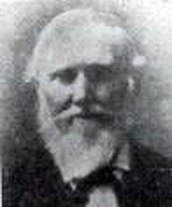

General Edward Hampton Tarrant
1799 - August 2, 1858
Edward Hampton Tarrant was born in South Carolina in 1799. Edward’s early life is a bit of a mystery, as we do not know who his parents were or his exact birthdate. He was described to be about 5 foot 10 inches tall with blue eyes and a fair complexion.
At the age of just 15 years old, Edward enlisted into the 14th Regiment with the Kentucky Detached Militia as a result of the ongoing War of 1812. He enlisted for a term of 6 months, but just three months into his military career, he was promoted to the rank of Corporal. He was later discharged on May 20, 1815 and was paid $10 for each month of his service.
By the early 1820’s, Edward had moved from Kentucky to Tennessee and by 1824 he was elected “Colonel of Militia.” The militia was created to protect themselves from Indian attacks in the rugged and wild hills of Tennessee. While in Tennessee he became a local leader in Henry County, especially the town of Paris, where he was elected sheriff (1827) and also established the local Masonic Lodge. In the 1830’s, he moved to Henderson County, Tennessee where he was the first clerk of the circuit court.
Accounts written by the Tarrant Family stated Edward came to Texas via the Mississippi River sometime in mid 1835 and established himself in Red River County. On February 2, 1838, Edward received a land grant from the Republic of Texas. This grant was awarded to all heads of household that were residents of Texas on March 2, 1836. Much like his life back in Tennessee, Edward soon found himself in public office again. He was appointed as the first Chief Justice of Red River County in December 1836 and built a successful law firm that would last until 1845. On October 17, 1837, he was sworn into office as a House of Representative for Red River County and worked under President Houston in the Republic of Texas.
While in office, tension became more strained in Texas as the threat from Indian tribes in East Texas was growing more hostile. Edward felt he would be of better service to his new country in a military capacity as he had experience defending land from the Indians back in Tennessee. He resigned his position with the House of Representatives on December 12, 1837. Although his time may have been short with the House of Representatives, it was during this time he would befriend several colleagues all located in the North Texas area with notable names such as Dr. Daniel Rowlett and Collin McKinney.
By the Fall of 1838, at the age of 39, he was the leader of the Red River County Militia where his main mission was to force the Indians away from the Republic of Texas and back into the United States. In 1840, his peaceful and resourceful relationship with the Indians helped him to be promoted to the rank of Brigadier General. Tarrant was instrumental in the signing of a peace treaty between the Republic of Texas and the Indians in 1843. Tarrant continued his life in public service and he was very active in statewide talks in regard to the annexation of Texas by the United States, which would come to fruition in December of 1845.
Tarrant lived in several other counties in the State of Texas including Robertson, Navarro, and Ellis. To honor him, a town was named Tarrant in 1846 and was the first county seat for Hopkins County. In 1849, he returned to the Texas House of Representatives where he would serve until 1853. In December of 1849, a new county was approved and was named Tarrant. The naming of the county for him paid tribute to his public and military service to Texas. During this time in his life, he would reside in Ellis County and was involved in the building of the city of Waxahachie.
On April 6, 1851, now in his 50’s, Edward married Mary Danforth. Mary was just 19 years old at the time of their marriage. Edward continued to purchase land in a variety of counties and by 1858, he had planned to move his family to the Fort Belknap area in Young County. However, tension with the Indians was rising again and many North Texas leaders convened a court in Weatherford (Parker County) to discuss the matter. The court met in June 1858, but upon arriving Tarrant was very sick. An expedition was created where many of the men in the meeting physically went to see the Comanches' interactions with the settlers. Tarrant was far too sick to travel and his illness would end his life on August 2, 1858 in Parker County.
His body was temporarily laid to rest in Parker County, but later removed and reburied at his family farm in Ellis County in January 1859. His remains would later be interred for the third and final time at Pioneers Rest Cemetery on March 3, 1928 in the county that bears his name.¹
__________________________
[1] Jones, Robert L & Pauline H. Jones. Edward H. Tarrant. The Southwestern Historical Quarterly, Volume 69, July 1965 - April, 1966; Pgs 300-323. Austin, Texas. Accessed 2 Oct 2023 ; https://texashistory.unt.edu/ark:/67531/metapth117144/m1/360/.

Block 4, Lot 54 [Explore the Map]



